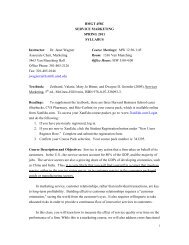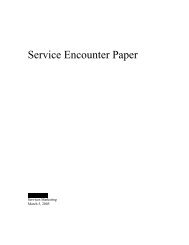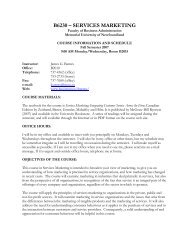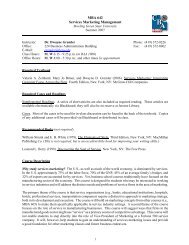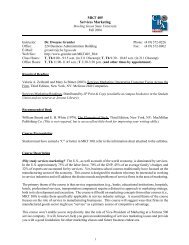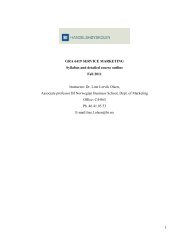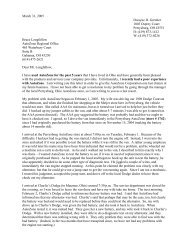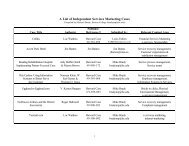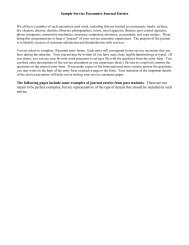D.D. <strong>Gremler</strong>, K.P. Gwinner / Journal of <strong>Retail</strong>ing 84 (3, 2008) 308–324 321CIT method (cf. <strong>Gremler</strong> 2004), including the assumption thatrespondents adequately understand the phenomena in questionand can provide relevant responses, its reliance on participants’recollections of incidents, and a bias toward more recent incidents.Second, our data refer to situations with good rapport anddo not identify any negative aspects of the phenomenon, whichmight limit our study findings (i.e., commonly used but ineffectivetactics may not be identified). Third, we focus on situationsin which rapport building is appropriate; however, rapport is nota panacea for employee–customer interaction issues, and wedo not contend that every interaction demands (or desires) rapport.Further research might develop a typology of situations toexamine when customers prefer interactions involving rapport.Fourth, rapport is a dyadic construct, in that it requirestwo parties. Yet we investigate it from a single point of view.Although we consider rapport-building behaviors from both customerand employee perspectives, we do not capture differentperspectives of the same incident. Additional studies shouldinvestigate both parties in the dyad of a single incident to obtain acomplete picture of rapport (cf. Ewing et al. 2001). Fifth, the CITmethod may not be well suited to capture the types of imitativebehavior identified in previous studies of rapport. For example,our study does not reveal whether imitative behaviors actuallyappear in service encounters; observational methods may be bettersuited to capture such behaviors. Sixth and finally, we didnot distinguish between rapport-building behaviors in ongoingversus initial encounters. The benefits of establishing customerrapport and the most effective method for doing so may differin interactions of varying length and intensity. Further researchshould investigate whether the type and/or effectiveness of suchbehaviors differ when the customer has no prior relationship withthe retailer (i.e., “first” encounters) versus when they are engagedin a long-term, ongoing encounter. For example, researchersmight compare short-term, potentially recurring conveniencestore transactions with long-term, relationship-driven financialservices.AcknowledgementThe authors gratefully acknowledge Scott Kelley and ShannonRinaldo for their assistance in data analysis.Appendix A. Instructions for codersA.1. Critical incident technique coding instructions1. You will be provided with a set of written descriptions ofa variety of service encounters. Each “story” or “event”is recorded on a standardized questionnaire. Each serviceencounter questionnaire reflects the events and behaviorsassociated with a memorable service encounter. The focusof the study is on identifying various rapport-building techniquesthat service employees use with customers. Two typesof questionnaires were used, one completed <strong>by</strong> customerrespondents and the other completed <strong>by</strong> employee respondents.2. You will be asked to identify each employee behavior inan incident that was an attempt to establish rapport withthe customer. Sorting rules and definitions of fourteen distincttypes (or categories) of such behaviors are detailedbelow.3. You should read through the entire service encounter beforeyou attempt to identify the various employee rapport-buildingbehaviors. If an incident does not appear to have any of thefourteen behaviors described below, put it aside. In addition,do not attempt to categorize incidents that do notmeet the basic criteria. In particular, an incident must: (1)include an employee–customer interaction, (2) reference aspecific service encounter, (3) provide sufficient informationto adequately assess the incident, and (4) contain anapparent attempt <strong>by</strong> the employee at building rapport withthe customer. If it does not meet all of these criteria, set itaside.4. Once you have read the incident, identify all of the rapportbuildingbehaviors and record those behaviors on theprovided data entry sheet.Appendix B. CIT classification system definitionsCategory 1. (Uncommonly attentive behavior) Theemployee provides attention perceived <strong>by</strong> the customer asunusual, out-of-the-ordinary, or unexpected.A. Atypical actions. The employee is perceived <strong>by</strong> the customeras going out of his or her way to do deeds or go “above andbeyond the call of duty” to please the customer or offeringany extra help that is not necessary. Such special attentionappears to help establish rapport with the customer.B. Personal recognition. The employee indicates recognitionof the customer through the recollection of a name orremembering specifics or relevant facts about that particularcustomer (or the customer’s family). Through suchrecognition, the customer feels as though the employee has“connected” with him or her.C. Intense personal interest. The employee demonstrates anintense level of interest in the customer as a person. Suchinterest in the customer’s situation is perceived <strong>by</strong> the customeras unexpected and out-of-the-ordinary and as anindication that the employee’s primary concern is for thecustomer (or his or her well-being), not making a sale.Category 2. (Common grounding behavior) The employeeseeks to discover (or discovers through serendipity) somethinghe or she has in common with the customer.A. Identifying mutual interests. The employee tries to find acommon interest with the customer to establish rapport(hobbies, hometown, sports teams, etc.). The employeesearches for any common interest that both the customerand employee might have to make an initial connection andkeep the conversation flowing.B. Finding other similarities. These behaviors refer to employeesidentifying other things the customer and employee have
322 D.D. <strong>Gremler</strong>, K.P. Gwinner / Journal of <strong>Retail</strong>ing 84 (3, 2008) 308–324in common besides interests (e.g., both just spent $20 ongasoline, both are 24 years old, both began taking swimminglessons when they were 6 months old).Category 3. (Courteous behavior) During the interaction,the employee demonstrates courteous behavior that appears tobe a natural part of the employee’s disposition. Such behavior isinterpreted <strong>by</strong> the customer as sincere and truly looking out forthe customer’s best interests rather than the company’s.A. Unexpected honesty. The employee is genuinely honest inhis or her discussion when answering questions or in othergeneral discussion. Such honesty leads to customer trust inthe employee and the establishment of rapport.B. Civility. The employee displays courteous behavior <strong>by</strong>being especially pleasant, polite, and/or helpful. Here, theemployee’s actions are not necessarily perceived as anexplicit attempt to establish a relationship.C. Empathy. The employee consoles the customer, acts withempathy, shows concern, displays care, and/or is apologeticabout the customer’s plight. The employee’s concern forthe customer and ability to see things from the customer’sviewpoint help establish rapport.Category 4. (Connecting behavior) In the normal courseof the service encounter, the employee explicitly attempts todevelop a connection with the customer.A. Using humor. The employee attempts to establish rapportthrough the use of humor. The employee makes a joke orgets the customer to laugh or smile to make a connection orestablish rapport.B. Pleasant conversation. <strong>Rapport</strong> appears to be establishedthrough the employee’s pleasant conversation with the customer.Although the employee initiates the conversation, itis not necessarily with any particular purpose in mind otherthan to engage in an enjoyable discussion or chat with thecustomer (e.g., asking how the customer is doing, engagingin small talk).C. Friendly interaction. The employee is particularly friendly,warm, personable, or nice in the process of serving the customer,beyond what is perceived as normal in this context.Such behavior, generally perceived as part of the employee’sjob, may help make the customer feel comfortable and/or puthim or her at ease in this setting.Category 5. (Information sharing behavior) The employeeattempts to share information with or gather information fromthe customer in the interaction to understand the customer morethoroughly and better serve him or her.A. Giving advice. The employee makes suggestions to the customerabout the service or product. Also, the employee mayprovide advice or insight into matters only indirectly relatedto the purchase situation.B. Imparting knowledge. <strong>Rapport</strong> develops as the employeeshares his or her own expertise and knowledge about a certainsubject with the customer. The sharing of such informationleads the customer to believe an initial connection was madein establishing rapport.C. Asking questions to understand customer and needs. <strong>Rapport</strong>is cultivated through the employee asking questions (beyond“can I help you?”) to find out what the customer is reallylooking for from the company and attempting to gain a betterunderstanding of specific customer needs. The customermay also perceive that the employee carefully listens to theanswers to such questions to make the customer feel morecomfortable.ReferencesAltman, Irwin (1990), “Conceptualizing <strong>Rapport</strong>,” Psychological Inquiry, 1 (4),294–323.Argyle, Michael (1990), “The Biological Basis of <strong>Rapport</strong>,” PsychologicalInquiry, 1 (4), 297–300.Andersen, Peter A. and Laura K. Guerrero (1998), “Principles of Communicationand Emotion in Social Interaction,” in Handbook of Communicationand Emotion, Andersen Peter A. and Guerrero Laura K., eds. San Diego,CA: Academic Press, 49–96.Beatty, Sharon E., Morris Mayer, James E. Coleman, Kristy Ellis Reynoldsand Jungki Lee (1996), “Customer–Sales Associate <strong>Retail</strong> Relationships,”Journal of <strong>Retail</strong>ing, 72 (Fall), 223–47.Bendapudi, Neeli and Leonard L. Berry (1997), “Customers’ Motivations forMaintaining Relationships With Service Providers,” Journal of <strong>Retail</strong>ing, 73(Spring), 15–37.Bendapudi, Neeli and Robert P. Leone (2002), “Managing Business-to-BusinessCustomer Relationships Following Key Contact Employee Turnover in aVendor Firm,” Journal of Marketing, 66 (April), 83–101.Ben<strong>net</strong>t, Jo. 2002. “The E-Motional Rescue of Self-Service Devices.” Inside1-to-1, (accessed September 12, 2005), [available at http://www.1to1.com/View.aspx?DocID=22865].Bernieri, Frank J., John S. Gillis, Ja<strong>net</strong> M. Davis and Jon E. Grahe (1996),“Dyad <strong>Rapport</strong> and the Accuracy of Its Judgment Across Situations: A LensModel Analysis,” Journal of Personality and Social Psychology, 71 (1),110–29.Bettencourt, Lance A. and Stephen W. Brown (1997), “Contact <strong>Employees</strong>:Relationships Among Workplace Fairness, Job Satisfaction, and ProsocialService <strong>Behaviors</strong>,” Journal of <strong>Retail</strong>ing, 73 (1), 39–61.Bettencourt, Lance A., Stephen W. Brown and Scott B. MacKenzie (2005),“Customer-oriented Boundary-spanning <strong>Behaviors</strong>: Test of a SocialExchange Model of Antecedents,” Journal of <strong>Retail</strong>ing, 81 (2), 141–57.Bitner, Mary Jo, Bernard H. Booms and Mary Stanfield Tetreault (1990), “TheService Encounter: Diagnosing Favorable and Unfavorable Incidents,” Journalof Marketing, 54 (January), 71–84.Bitner, Mary J. and Amy R. Hubbert (1994), “Encounter Satisfaction VersusOverall Satisfaction Versus Quality,” in Service Quality: New Directions inTheory and Practice, Rust R. T. and Oliver R. L., eds. New York: SagePublications, 72–84.Brady, Michael K. and Joseph Cronin Jr. (2001), “Some New Thoughts on ConceptualizingPerceived Service Quality: A Hierarchical Approach,” Journalof Marketing, 65 (July), 34–49.Brown, Stephen W. and Teresa A. Swartz (1989), “A Gap Analysis of ProfessionalService Quality,” Journal of Marketing, 54 (April), 92–8.Campbell, Kim Sydow, Lenita Davis and Lauren Skinner (Fall 2006), “<strong>Rapport</strong>Management during the Exploration Phase of the Salesperson-CustomerRelationship,” Journal of Personal Selling and Sales Management, 26359–70.Chartrand, Tanya L. and John A. Bargh (1999), “The Chameleon Effect: ThePerception-Behavior Link and Social Interaction,” Journal of Personalityand Social Psychology, 76 (6), 893–910.Chase, Richard B. and Douglas M. Stewart (1994), “Make Your Service Fail-Safe,” Sloan Management Review, 35 (Spring), 35–44.



